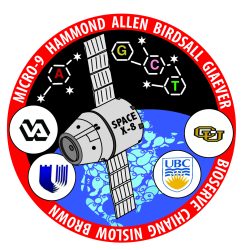Micro-9 (SpaceX-8)
Yeast Colony Survival in Microgravity Depends on Ammonia Mediated Metabolic Adaptation and Cell Differentiation
Micro-9 is a life science research investigation that examines how spaceflight and microgravity affect the mechanisms of cell biology. The study will use multiple genetic strains of the yeast model organism Saccharomyces cerevisiae to enhance our understanding of how life responds to physical phenomena and physical forces. The study investigates specific mechanisms of yeast cell signaling and response to microgravity.
The investigation is planned to launch to the International Space Station aboard NASA’s eighth cargo resupply flight of the Space Exploration Technologies (SpaceX) Dragon spacecraft on April 8, 2016.
The movement of molecules within fluids is affected by changes in the force of gravity. Variations in the movements of cell-signaling molecules induced by microgravity may be responsible for certain impacts of the spaceflight environment on living systems. Micro-9 studies how microgravity affects specific cell signaling pathways that use molecules of ammonia to transmit signals and evaluates the role of ammonia-based signaling in the cellular and genetic differentiation of giant yeast colonies and the response to spaceflight.
Because there are similarities between multicellular yeast colonies and tumors or clusters of mammalian cells in tissue culture, insights into the effect of microgravity on cell to cell signaling gained by studying yeast colonies may have far-reaching applications. An understanding of the biological characteristics and functions of yeast cells, both as individual elements and also as components of colonies, contributes to a better understanding of normal and abnormal behavior of organs and tissues in other species and humans in particular.
Additionally, data from this study will provide further insights into identifying cellular factors that may contribute to crew health risks and may facilitate the future development of countermeasures to protect crew health.
Spaceflight provides a unique opportunity for researchers to probe the metabolic pathways of tumors because microgravity changes the electrical or redox state—which refers to the loss or gain of electrons from reduction or oxidation—of normal yeast cells in a way that mimics the redox state of tumor cells on Earth. Thus knowledge gained from Micro-9 may also provide valuable insights that can applied in the area of cancer therapy.
Micro-9 is managed and supported by the Space Biology Project at NASA’s Ames Research Center in California’s Silicon Valley. Funding for Space Biology comes from the Space Life and Physical Sciences Research and Applications Division within the Human Exploration and Operations Mission Directorate at NASA Headquarters. The Micro-9 hardware/payload developer and implementation partner is BioServe Space Technologies, University of Colorado, Boulder.
Project manager: Elizabeth Pane, Space Biosciences Division, NASA’s Ames Research Center
Project scientist: Fathi Karouia, Ph.D., Space Biosciences Division, NASA’s Ames Research Center
Principal investigator: Timothy G. Hammond, M.B.B.S., Institute for Medical Research, Inc., Durham VA Medical Center
Co-investigator: Holly Birdsall, M.D., Ph.D., Baylor College of Medicine, and U.S. Department of Veterans Affairs
Co-investigator: Corey Nislow, Ph.D., University of British Columbia
Co-investigator: Guri Giaever, Ph.D., University of British Columbia
Co-investigator: Patricia Allen, M.S., U.S. Department of Veterans Affairs




























